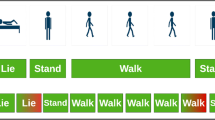Abstract
This paper introduces a concept for an assistance system that enables nursing staff in real-life clinical settings to reduce the time-consuming nursing documentation effort, e.g. from the morning routine. The overall goal is an AI-based documentation assistant that pre-fills the documentation record. An essential constraint in collecting and processing data is the use of sensors and features that preserve people’s privacy and the acceptance of being observed.
The selected sensors are known body-worn acceleration sensors as well as far-infrared based thermal scans. During the training and evaluation phase, the use of an Azure Kinect is foreseen as well. A crucial intermediate step within the AI based concept is the autonomous identification and learning of actions that form an activity that is recognised as a part of the entire routine added to the documentation. Both open data sets and self-recorded material tailored to the use case are to be used for this purpose. By checking the automatically generated documentation results after each treatment by the nursing staff, additional training material is to be constantly generated during the application operation in order to improve the pattern recognition systems in the processing layer in the long term.
Access this chapter
Tax calculation will be finalised at checkout
Purchases are for personal use only
Similar content being viewed by others
References
Bertram, J., et al.: Accuracy and repeatability of the microsoft azure Kinect for clinical measurement of motor function. PloS One 18, e0279697 (2023). https://doi.org/10.1371/journal.pone.0279697
Bruns, F.T., Pauls, A., Koppelin, F., Wallhoff, F.: Activity recognition of nursing tasks in a hospital: requirements and challenges. In: Salvi, D., Van Gorp, P., Shah, S.A. (eds.) PH 2023. LNICS, Social Informatics and Telecommunications Engineering, vol. 572, pp. 235–243. Springer, Cham (2024). https://doi.org/10.1007/978-3-031-59717-6_16
Dall’Ora, C., Ball, J., Reinius, M., Griffiths, P.: Burnout in nursing: a theoretical review. Hum. Resour. Health 18(1), 41 (2020). https://doi.org/10.1186/s12960-020-00469-9
Demrozi, F., Turetta, C., Machot, F.A., Pravadelli, G., Kindt, P.H.: A comprehensive review of automated data annotation techniques in human activity recognition (2023). https://doi.org/10.48550/ARXIV.2307.05988
Ijaz, M., Diaz, R., Chen, C.: Multimodal transformer for nursing activity recognition. In: Proceedings: IEEE Conference on Computer Vision and Pattern Recognition, pp. 2064–2073 (2022). https://doi.org/10.1109/CVPRW56347.2022.00224
Inoue, S., Alia, S.S., Lago, P., Goto, H., Takeda, S.: Nurse care activities datasets: in laboratory and in real field (2020). https://doi.org/10.21227/jem3-ap07
Joukes, E., Abu-Hanna, A., Cornet, R., de Keizer, N.F.: Time spent on dedicated patient care and documentation tasks before and after the introduction of a structured and standardized electronic health record. Appl. Clin. Inform. 09(01), 046–053 (2018). https://doi.org/10.1055/s-0037-1615747
Kaufmann, T., Weng, P., Bengs, V., Hüllermeier, E.: A survey of reinforcement learning from human feedback (2024). https://arxiv.org/abs/2312.14925
Okuda, R., Xia, Q., Maekawa, T., Hara, T., Inoue, S.: Activity prediction method for nursing care records with missing entries. Int. J. Act. Behav. Comput. (2024)
Acknowledgements
This study was supported by the Lower Saxony Ministry for Science and Culture with funds from the governmental funding initiative zukunft.niedersachsen of the Volkswagen Foundation, project “Data-driven health (DEAL)”.
The experiment complied with the Declaration of Helsinki and was approved by the ethics committee of the University of Oldenburg with approval identifier Drs.EK/2024/027.
Furthermore the authors would like to express their thanks to the undergraduate student Fabian Kessener for building the training database.
Author information
Authors and Affiliations
Corresponding author
Editor information
Editors and Affiliations
Rights and permissions
Copyright information
© 2025 The Author(s), under exclusive license to Springer Nature Switzerland AG
About this paper
Cite this paper
Wallhoff, F., Hesselmann, F.T. (2025). Nursing Activity Recognition for Automated Care Documentation in Clinical Settings. In: Bramer, M., Stahl, F. (eds) Artificial Intelligence XLI. SGAI 2024. Lecture Notes in Computer Science(), vol 15447. Springer, Cham. https://doi.org/10.1007/978-3-031-77918-3_19
Download citation
DOI: https://doi.org/10.1007/978-3-031-77918-3_19
Published:
Publisher Name: Springer, Cham
Print ISBN: 978-3-031-77917-6
Online ISBN: 978-3-031-77918-3
eBook Packages: Computer ScienceComputer Science (R0)




